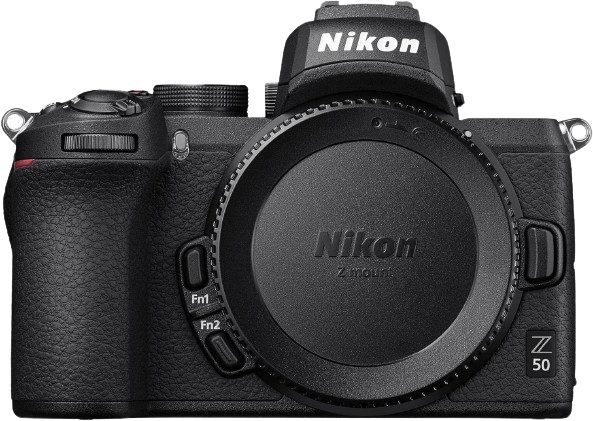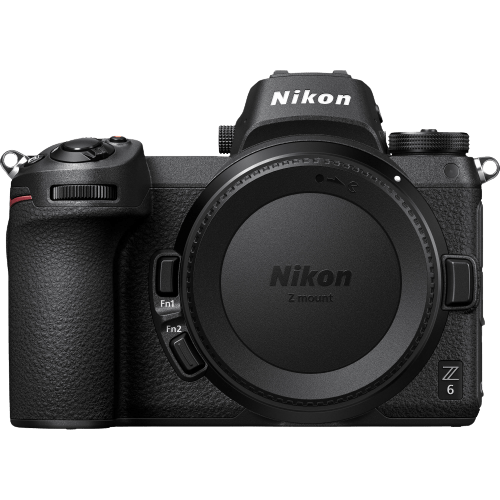Nikon Z50 vs Z6 Comparison
Nikon Z50

Nikon Z6

The Nikon Z6 takes the lead with a score of 81/100, while the Nikon Z50 trails behind at 73/100. Both cameras share similarities as mirrorless models, released in 2018 and 2019 respectively. They differ in price, with the Z6 priced at $2000 and the Z50 at $859.
The Z6 outperforms the Z50 in terms of size and weight, measuring 134 x 101 x 68mm and weighing 1.49lbs. The Z50 is smaller and lighter at 127 x 94 x 60mm and 0.99lbs. This makes the Z6 more suitable for professional use, while the Z50 is ideal for casual photographers.
Despite its lower score, the Z50 has a more budget-friendly price point, making it a great option for those who are new to photography or on a tighter budget. The Z6, with its higher score, caters to more advanced photographers who require a superior performance.
Both cameras have their merits, with the Z6 offering better overall performance and the Z50 providing a more accessible option for newcomers to photography.
Nikon Z50 vs Z6 Overview and Optics
The Nikon Z6 is the superior camera when it comes to optics, with a score of 83/100 compared to the Nikon Z50’s 72/100. Both cameras share some common specifications, such as the CMOS sensor type, Expeed 6 processor, and Nikon Z lens mount.
The Z6 outperforms the Z50 in several aspects. It has a higher resolution with 24.5 megapixels, compared to the Z50’s 21 megapixels. This results in sharper and more detailed images. The Z6 also has a faster shooting speed of 12 frames per second, compared to the Z50’s 11 frames per second. This advantage allows for capturing fast-moving subjects more efficiently. Furthermore, the Z6 has a full-frame sensor, which provides better image quality and low-light performance than the Z50’s APS-C sensor. Additionally, the Z6 features image stabilization, which helps to reduce camera shake and produce sharper images, while the Z50 lacks this feature.
On the other hand, the Z50 has a higher DXOMARK score for its sensor, with a score of 97 compared to the Z6’s 95. This means that the Z50’s sensor performs slightly better in terms of dynamic range, color depth, and low-light ISO performance. However, this advantage may not be significantly noticeable in everyday photography.
Comparing the optics of both cameras, the Nikon Z6 is the clear winner due to its higher resolution, faster shooting speed, full-frame sensor, and image stabilization. The Nikon Z50 does have a slightly better sensor performance according to its DXOMARK score, but this advantage is not enough to outweigh the superior features of the Z6.
Nikon Z50 vs Z6 Video Performance
The Nikon Z50 emerges as the winner in the video capabilities comparison, scoring 91/100 compared to the Nikon Z6’s 83/100. Both cameras share common specifications, including a maximum video resolution of 4K and video dimensions of 3840 x 2160. Additionally, both cameras feature built-in time-lapse functionality.
The Nikon Z50 outperforms the Z6 due to its higher maximum video frame rate of 120fps, which is double the Z6’s 60fps. This higher frame rate allows the Z50 to capture smoother slow-motion footage and provides more flexibility in post-production. The Z50’s superior video capabilities make it the better choice for videographers looking for a camera with advanced video features.
On the other hand, the Nikon Z6 still has respectable video capabilities, matching the Z50 in terms of video resolution and dimensions. Its 60fps frame rate is sufficient for most video applications, and the built-in time-lapse functionality is a valuable feature for both cameras. Although it doesn’t perform as well as the Z50, the Z6 is a reliable option for those seeking a camera with solid video performance.
Comparing the video capabilities of the Nikon Z50 and Z6, it is clear that the Z50 has the advantage due to its higher maximum video frame rate. The Z6, while still a capable camera, falls short in this aspect. However, both cameras share key video features, making them suitable options for different users depending on their specific video requirements.
Nikon Z50 vs Z6 Features and Benefits
The Nikon Z6 emerges as the winner in the features comparison, scoring 87/100, just one point higher than the Nikon Z50, which scores 86/100. Both cameras share several specifications, including a 3.2-inch screen size, touchscreen capabilities, and the absence of GPS. Additionally, both cameras are equipped with WiFi and Bluetooth connectivity.
The Nikon Z6 outperforms the Z50 in terms of screen resolution, boasting 2,100,000 dots compared to the Z50’s 1,040,000 dots. This difference results in a sharper and clearer display on the Z6, enhancing image review and menu navigation experiences for photographers.
On the other hand, the Nikon Z50 has a flip screen, which the Z6 lacks. This feature allows for more versatile shooting angles and is particularly useful for vloggers and content creators who need to monitor their compositions while filming themselves. Despite its lower screen resolution, the Z50’s flip screen gives it an edge in usability for certain users.
Taking these points into account, the Nikon Z6 offers a superior screen resolution, making it an ideal choice for photographers who prioritize image clarity. However, the Nikon Z50’s flip screen provides added versatility, catering to the needs of vloggers and content creators. Both cameras are strong contenders in their respective areas, and the final decision depends on individual preferences and shooting requirements.
Nikon Z50 vs Z6 Storage and Battery
The Nikon Z50 and Nikon Z6 share the same storage and battery score of 35/100. Both cameras have a single memory card slot, and they support USB charging. The Z50 accepts SD, SDHC, and SDXC (UHS-I compatible) memory cards, while the Z6 uses XQD cards.
The Z50 has a slight advantage in battery life, providing 320 shots per charge compared to the Z6’s 310 shots. The Z50 uses an EN-EL25 battery, while the Z6 uses an EN-EL15b battery. This small difference in battery life may be beneficial for photographers who require longer shooting sessions.
The Z6, on the other hand, uses XQD cards which offer faster read and write speeds than SD cards. This can be advantageous for photographers who need to transfer large amounts of data quickly.
Despite the minor differences in battery life and memory card compatibility, both cameras perform similarly in terms of storage and battery capabilities. The choice between the two will depend on individual preferences for battery life and memory card type.
Alternatives to the Nikon Z50 and Z6
Are you still undecided about which camera is right for you? Have a look at these popular comparisons that feature the Nikon Z50 or the Nikon Z6:

